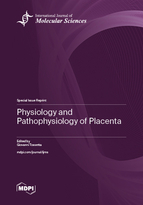Physiology and Pathophysiology of Placenta
A special issue of International Journal of Molecular Sciences (ISSN 1422-0067). This special issue belongs to the section "Molecular Pathology, Diagnostics, and Therapeutics".
Deadline for manuscript submissions: closed (30 November 2023) | Viewed by 14799
Special Issue Editor
Interests: pregnancy complications; preeclampsia; preterm birth; ovarian cancer; early marker of pregnancy complications; oxidative stress; chemoresistance
Special Issues, Collections and Topics in MDPI journals
Special Issue Information
Dear Colleagues,
The development and differentiation of placental villous trees are two key processes tightly regulated during pregnancy. In fact, several growth factors, their receptors and other types of molecules can regulate placental cell proliferation, differentiation, migration and invasion. Thus, an impairment of normal placental development can lead to a series of pregnancy pathologies, i.e., preeclampsia (PE), fetal growth restriction (FGR), gestational trophoblastic diseases (GTD) and gestational diabetes mellitus (GDM). Furthermore, external factors, such as microbial agents, chemicals and natural compounds, can affect placental development and function impairing pregnancy outcomes.
These pregnancy complications result in increased maternal and fetal mortality and morbidity, leading to life-long health implications in both mother and child.
The aim of this Special Issue is to provide an overview of placental development and pathophysiology in order to better understand the molecular mechanisms involved in pregnancy. We are inviting submissions of original research articles, reviews and mini-reviews on topics relevant to any aspect of placental physiology, pathophysiology, biochemistry and molecular biology.
Dr. Giovanni Tossetta
Guest Editor
Manuscript Submission Information
Manuscripts should be submitted online at www.mdpi.com by registering and logging in to this website. Once you are registered, click here to go to the submission form. Manuscripts can be submitted until the deadline. All submissions that pass pre-check are peer-reviewed. Accepted papers will be published continuously in the journal (as soon as accepted) and will be listed together on the special issue website. Research articles, review articles as well as short communications are invited. For planned papers, a title and short abstract (about 100 words) can be sent to the Editorial Office for announcement on this website.
Submitted manuscripts should not have been published previously, nor be under consideration for publication elsewhere (except conference proceedings papers). All manuscripts are thoroughly refereed through a single-blind peer-review process. A guide for authors and other relevant information for submission of manuscripts is available on the Instructions for Authors page. International Journal of Molecular Sciences is an international peer-reviewed open access semimonthly journal published by MDPI.
Please visit the Instructions for Authors page before submitting a manuscript. There is an Article Processing Charge (APC) for publication in this open access journal. For details about the APC please see here. Submitted papers should be well formatted and use good English. Authors may use MDPI's English editing service prior to publication or during author revisions.
Keywords
- trophoblast
- proliferation
- differentiation
- invasion
- placenta
- preeclampsia
- fetal growth restriction
- gestational diabetes mellitus
- infection
- pregnancy complications







